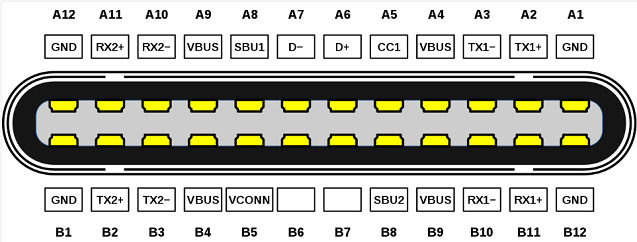A standard for the appearance of USB interfaces is called USB Type-C. Its volume is less than that of Type-A and Type-B. It is applicable to interfaces between PCs (master devices) and external devices (slave devices, like mobile phones). type.
Four pairs of TX/RX split lines, two pairs of and four ground wires make up USB Type-C.
Ⅰ. Definition of pin
The Type-C port's , which is defined as having 4 pairs of TX/RX branch lines, 2 pairs of, and 4 ground wires, must first be understood in order to comprehend the Type-C standard's basic principles.
Naturally, if the receiving end only requires DP signals and not USB 3.1 signals, DP can utilize all 4 pairs of TX/RX differential lines for output, realizing DP output of up to 4 lanes and providing a total output bandwidth of up to , easily realizing 60-frame video, and even up to 8 60-frame video (4:2:0 data), in this DP only mode
Moreover, Type-C maintains the USB D+/D- signal for USB 2.0 devices, making it compatible with USB 2.0 devices. By using the Type-C interface, USB 2.0 and even USB 1.0 devices can support front and rear insertion. It is important to note that the DP+USB 2.0 mode can be achieved by using USB D+/D- in addition to the DP alone mode described above. While USB simply employs D+/D-, DP uses 4 pairs of TX/RX differential lines. Because the USB Type-C Connector lacks B6 and B7, the USB 2.0 differential signal is typically only linked to one side.
Only two pairs of TX/RX differential lines are used by USB 3.1 as data lines. Whether plugging forward or backward, connect , respectively. As seen, there will always be 2 pairs of differential lines that are not used. The DP alternate mode allows USB 3.1 and DP to operate simultaneously by loading the DP signal into two pairs of differential lines that are "redundant."
Moreover, Type-C offers 2 CC lines and 2 lines. The Power Delivery module communicates mostly using the CC line. The CC line is first utilized to determine whether the gadget should be inserted forward or backward. You can tell that CC uses a single-wire protocol because the host communicates with the device using when it is inserted forward and when it is inserted backward.The line transmits important data like the device's when the DP function is activated. It is known as the AUX P/AUX N differential line in the DP protocol, and its polarity can be changed depending on the forward and reverse insertion orientations.

Figure. 1 USB Type-C Receptacle End View

Figure. 2 USB Type-C Plug Terminal View
Ⅱ. Technical characteristics
At the Consumer Electronics Show on January 7, 2013, the USB 3.0 marketing group declared that the first batch of products with a transmission rate of will be accessible in 2014. These items' USB interfaces adhere to the USB 3.1 specification, or Type-C interface.
The Type-C interface's socket end is around in size and has a compact design; it supports the "front and back insertion" capability that allows for insertion from either side and can survive 10,000 repeated insertions and extractions. The standard specification cable enables "USB PD," which is more powerful than the current USB power supply and can deliver a maximum power of , and can pass a current of .
Ⅲ. Type difference
The most popular interface type in computers and electrical equipment is Type-A. This interface has the largest volume and makes the most use of the mouse, Hard disk, and data cable.
For external USB devices like printers, scanners, Type-B is typically utilized.
Comparing Type-C to Type-A and Type-B, the volume is significantly lower. The newest USB interface standard is this one. This interface can be plugged in and disconnected at will, and the front and back directions are identical.
Ⅳ. Main features
Electronic gadgets have USB ports for data interchange, whether it be a Computer, tablet, phone, or even a display device—almost without exception, there is a USB interface. Yet, the USB plug has because of the limitations of technical standards. It will either not be inserted or the interface or connector will be harmed if it is inserted the wrong way.
In response, Apple created the Lightning interface for its products, allowing users to plug in their gadgets in either direction without having to worry about doing so. The industry has actually launched a similar interface standard called USB Type-C in addition to Apple gadgets.
Apple was the company that started the USB Type-C movement, and the new will support USB Type-C. It is brought into our area of vision, this strong technology. A Type-C connector and a Type-C socket make up the interface specification known as USB Type-C. Type-C has emerged as the most promising data interface among various mobile devices and Computers. As Type-C technology continues to develop, a number of new electrical goods released in 2017 have made the decision to come standard with full Type-C connectors.
In fact, the most obvious benefit of Type-C is that it eliminates the hassle of plugging in the cable completely. Due to its outstanding positive and negative interface design, incorrect insertion or other faults won't result in component damage. More significantly, because of its strong compatibility, the Type-C interface has evolved into a standardized interface that can connect all electronic devices, including computers, gaming consoles, smartphones, storage devices, and expansion, and realize the unification of data transmission and power supply. A Type-C cable is used to connect and use two display devices in close proximity.
The USB 3.1 specification is also supported by Type-C. This standard has a maximum power supply, higher voltage and current, and lower encoding consumption (3% instead of 20% of 3.0). In other words, consumers can charge more quickly or transfer data and video quickly with Type-C.
Users would be able to charge other devices with their phones thanks to the standard. While using Type-C for data transmission, it is not necessary to utilize a separate power cord to power the display, which eliminates the issue of tangled desktop cables. But, Type-C does not support the relatively expensive HDMI and DP interfaces.
Ⅴ. Standard protocol
The newest USB Type-C interface and cable standard protocol was released in September 2021 by the USB-IF association, and the power supply capacity was increased from Gaming laptops won't even require a separate power in the future.
According to Apple Insider, EU regulators approved a long-planned proposal on April 21, 2022, requiring Apple and all tech businesses to embrace USB-C as a universal charger and adding new specifications for wireless charging standards.
Ⅵ. Report data
The research company determined in its "2021 USB Type-C Study" that in 2020, approximately 80% of laptops and almost 50% of smartphones will have a USB-C interface, and that usage of these two products will continue to rise.
In addition to paving the way for new applications like portable desktop displays and universal docking stations, the adoption of these core devices fuels the proliferation of satellite devices.
The primary devices most likely to offer full-featured USB-C, with power, data, and audio-visual signals all available over a single line, are laptops and smartphones.
Ⅶ. Related news
The European Parliament decisively approved a measure on October 4, 2022, mandating that starting in the fall of 2024, smartphones, tablets, and other electronic devices sold in the EU must use USB type-C (USB-C for short). Readers, digital cameras, headphones, handheld video game consoles, and portable speakers all have standard charging connectors; starting in 2026, USB-C will also be the norm for laptop chargers.
The European Council decided on October 24, 2022, that starting in 2024, all types of electronic devices marketed in the EU, including smartphones, tablets, and digital cameras, must uniformly use the Type-C charging interface. You can decide whether you get an extra charger. A 40-month grace period is given for laptops to use the universal charging connector.
Apple stated on October 25, 2022, that it will adhere to EU regulations and that starting in 2024, all devices will utilize the USB-C charging connector uniformly.


